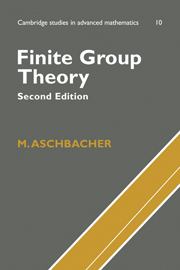Book contents
- Frontmatter
- Contents
- Preface
- 1 Preliminary results
- 2 Permutation representations
- 3 Representations of groups on groups
- 4 Linear representations
- 5 Permutation groups
- 6 Extensions of groups and modules
- 7 Spaces with forms
- 8 p-groups
- 9 Change of field of a linear representation
- 10 Presentations of groups
- 11 The generalized Fitting subgroup
- 12 Linear representations of finite groups
- 13 Transfer and fusion
- 14 The geometry of groups of Lie type
- 15 Signalizer functors
- 16 Finite simple groups
- Appendix
- References
- List of Symbols
- Index
7 - Spaces with forms
Published online by Cambridge University Press: 05 June 2012
- Frontmatter
- Contents
- Preface
- 1 Preliminary results
- 2 Permutation representations
- 3 Representations of groups on groups
- 4 Linear representations
- 5 Permutation groups
- 6 Extensions of groups and modules
- 7 Spaces with forms
- 8 p-groups
- 9 Change of field of a linear representation
- 10 Presentations of groups
- 11 The generalized Fitting subgroup
- 12 Linear representations of finite groups
- 13 Transfer and fusion
- 14 The geometry of groups of Lie type
- 15 Signalizer functors
- 16 Finite simple groups
- Appendix
- References
- List of Symbols
- Index
Summary
Chapter 7 considers pairs (V, f) where V is a finite dimensional vector space over a field F and f is a nontrivial sesquilinear, bilinear, or quadratic form on V. We'll be primarily interested in the situation where Aut(V, f) is large; in that event f satisfies one of several symmetry conditions (cf. Exercises 7.9, 7.10, 9.1, and 9.9). Under suitable restrictions on F, such pairs are determined up to isomorphism in sections 19, 20, and 21. For example if F is finite the isomorphism types are listed explicitly in section 21.
It turns out that such spaces satisfy the Witt property: that is, if X and Y are subobjects of (V, f) and α: X → Y is an isomorphism, then α extends to an automorphism of (V, f). As a result the representation of Aut(V, f) on (V, f) is particularly useful in investigating Aut(V, f).
The groups Aut(V, f), certain normal subgroups of these groups, and their images under the projective map of section 13 are called the classical groups. Section 22 derives various properties of the classical groups. For example for suitable fields they are essentially generated by their transvections or reflections, and are essentially perfect. It will develop much later in section 41 that if G is a perfect finite classical group then the projective group PG is simple. Conversely the Classification Theorem for finite simple groups says that, by some measure, most of the finite simple groups are classical groups.
- Type
- Chapter
- Information
- Finite Group Theory , pp. 75 - 104Publisher: Cambridge University PressPrint publication year: 2000

